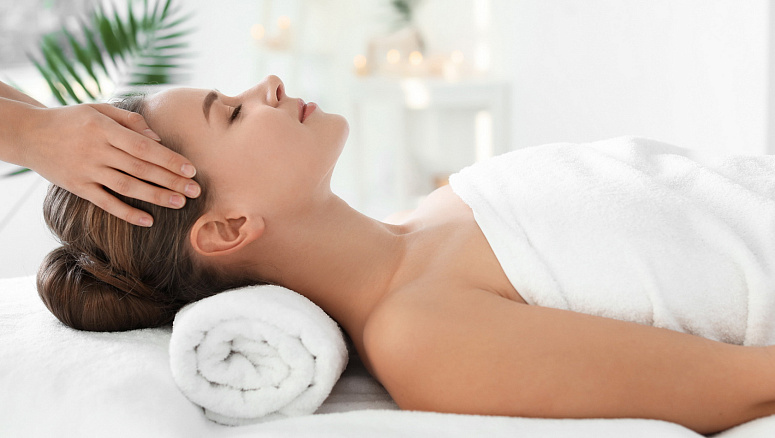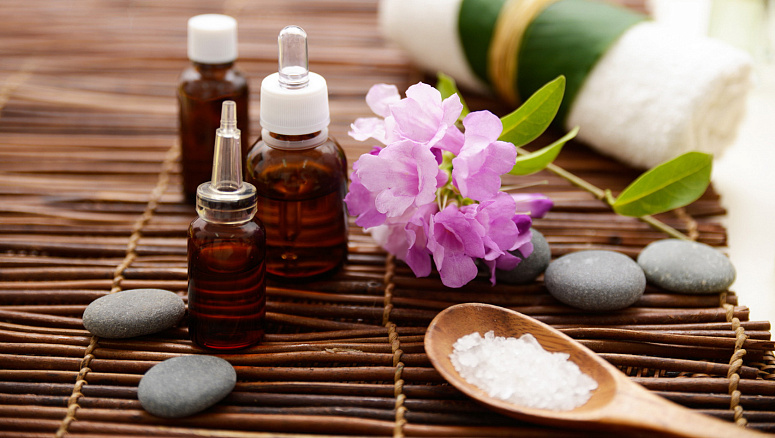Warning: This article is rooted in the principles of Ayurveda and is intended for informational purposes only. It is not a substitute for professional medical advice, diagnosis, or treatment. Before making any changes to your diet or lifestyle, especially if you have a chronic condition, please consult your healthcare provider or a certified nutrition specialist.
Abhyanga is recommended in Ayurveda as a cleansing procedure. It is an oil massage or oil rub, the positive effects of which have been known to Ayurvedic doctors for thousands of years. Literally, Abhyanga stands for “driving” or “rubbing” oil into the body. The goal of Abhyanga is not to massage and knead the body, but to rub oil into the skin.
According to Ayurveda, toxins accumulated in the body have a fat-soluble nature, so oil promotes the removal of gathered ama (waste and toxins). This is not coincidental, since skin is technically an intestine turned inside out- everything that passes through our skin becomes absorbed into the body.
Oil dissolves toxins and then returns them to their source - the intestine. From the intestine, the eradication of toxins occurs in an ordinary manner: through defecation and urination. A clean body helps us stay young and active for as long as possible, slow down aging processes and possess lots of energy - a goal that most of us strive towards.
Our body is permeated with various channels: capillaries, pores, blood vessels, intestines. Each cell in our body can be viewed as an individual organism that absorbs substances and cleanses itself by processing and expelling them.
Obstruction of these channels causes the removal of wastes, impurities and toxins to be disrupted, leading to malabsorption of oxygen and nutrients as well as rapid depletion of body tissue. With the help of oiling, the channels become soft and elastic, allowing waste products to be evacuated in the best possible way.
Abhyanga - what is it?
Abhyanga is a part of dinacharya, the compiled daily recommendations that each person should follow from the moment of their awareness, or sometimes even earlier, to their very death. It is an oil massage that is part of the morning cleansing routine, during the process of which oil is rubbed into the body. Abhyanga is also one of the panchakarma treatments.
Abhyanga consists of five key purification and cosmetology methods:
- nutrition;
- cleansing;
- toning;
- hydration/moisturization;
- protection.
It is known that thousands of nerve endings connect the skin to all other organs and tissues of the body; therefore, the entire mental-physical system can be calmed and benefited through the skin’s surface. When Abhyanga is conducted, all of the organism’s malfunctions are addressed simultaneously on three levels: physical, mental and psychological.
Abhyanga at home: a step-by-step instruction
- Prepare around 70-100 grams of vegetable oil for the Abhyanga procedure; sesame oil is ideal, but starting with sunflower, olive, or any other oil will also work well. Using cosmetic oils for Abhyanga, however, is not recommended.
Sesame oil is suitable for Vata dosha (it’s actually considered universal for all three) as well as almond or olive oil.
For Pitta-dosha, coconut or sunflower oil is ideal.
For Kapha-dosha, sesame or mustard oil.
You should also prepare chickpea, pea or oat flour (if none of those are available, you can grind regular rolled oats in a coffee grinder). Wheat flour should not be used due to its high gluten content!
- Oil should be heated in preparation for Abhyanga, possibly just before the procedure. You need to place a metal cup on the stovetop and, at the first signs of crackling or movement from the bottom (this is clearly visible), transfer the oil to another container so it can cool before the treatment.
- Then, we begin applying ubtan, an exfoliating blend of natural ingredients. Chickpea or oat flour can be mixed with turmeric, dry clay, herbs, dry milk, even ground coffee and essential oils. The flour will serve as “soap” and remove excess unabsorbed oil from the skin. A small amount of water or milk should be added to this mix of ingredients, ubtan, and brought to the consistency of thick sour cream. While ubtan soaks in the water, apply the warmed oil to your body.
- An important condition for Abhyanga is a warm room for oiling, which allows oil to penetrate deeply into the body. The procedure can be up to 30 minutes in length. Feelings of weariness or loss of energy should not arise after the procedure; if this does occur, it’s a clear signal that the oil has been on your body for too long and the total treatment time should be shortened.
- Scoop the warm oil into a handful and start slowly applying the oil to your body using light motions. You can wait for several minutes while the skin absorbs the oil, making even, stroking movements moving outward to the skin’s periphery, in the direction of hair growth or arterial blood flow, evenly distributing the pressure. Devote attention to all parts of the body: palms, fingers, feet, ears. After the massage, leave the oil to do its primary job - cleaning your body - for 10-15 minutes. Take your time and enjoy the sensations of the oiling.
- Oil is the best solver for toxins in the intercellular space. It should be kept on the body for no fewer than 8 minutes, so that it can reach your bones during the treatment time. It shouldn’t be cold in the bathroom/shower during Abhyanga, and a similar warm temperature should be maintained in the two hours following the procedure. Be at peace during the oiling, turn on pleasant music and dissolve in the oil with your body and mind.
- To remove the oil from your skin, ubtan is applied in a procedure called Udvaranta. This treatment is also described in Ayurveda as a separate massage method, but in this case the flour acts as an oil absorbent after the Abhyanga, leaving the skin smooth and pleasantly velvety. If you added coffee or another scrubbing ingredient, you will also experience the effect of a light scrub. Strive to perform this procedure daily in order to feel the greatest effect. Neither shower gel nor soap is necessary after the treatment, and it is best not to use ubtan to wash oil off your hair. The water for rinsing should not be hot, to avoid boiling of the mixture.
After Abhyanga, it’s recommended to avoid going outdoors for a minimum of 2 hours, remaining in a warm heated room.
Benefits of Abhyanga
- delays the aging process
- allows the body to rest
- calms Vata-dosha and Pitta-dosha
- harmonizes Kapha-dosha
- moisturizes the body
- improves condition of skin, giving it a healthy tone
- activates internal organs
- improves sleep
- reduces anxiety, bringing peace and tranquility
- nourishes the body by reducing dryness and constipation
- improves hearing (through ear oiling)
- prevents headaches; reduces gray hair and makes it healthier (through scalp oiling)
“Abhyanga means massage. It should be done daily, morning. It delays aging, relieves tiredness and excess of Vata (aches and pains). It improves vision, nourishes body tissues, prolongs age, induces good sleep and improves skin tone and complexion. Massage should be specially done on ears, head and legs.”
Precautions and contraindications
- Women should refrain from Abhyanga during menstruation
- In the case of Vata blockages caused by ama, oiling the whole body isn’t advised but the head and feet can be oiled
- Be careful if your situation involves obesity! It’s necessary to consult an Ayurvedic specialist
- For indigestion, i.e. obvious digestion problems, oiling should be avoided
- Elevated body temperature during periods of inflammatory exacerbation is also a contraindication
If any contraindications apply, sesame and other oils should be applied only to the soles of your feet, auricles (outer ears), and head rather than the entire body.
Even though Abhyanga is a morning procedure in Ayurveda, it can be performed in the evening if there is not enough time in the early hours of the day.
Abhyanga helps develop muscles, joints, ligaments, and skin; the healing effect is achieved by letting oils directly into the bloodstream or lymph. With regular massage, nerve fibers are nourished, slowing down aging and normalizing sleep - a great benefit in addition to the cosmetic effect. One of the main advantages of Abhyanga is that this treatment can be done at home!
This is a true joy for the body and an excellent habit for the start of each day - throughout the entire day, stability and emotional balance will be guaranteed for you!
The views expressed are based on traditional Ayurvedic texts and do not constitute medical advice.


